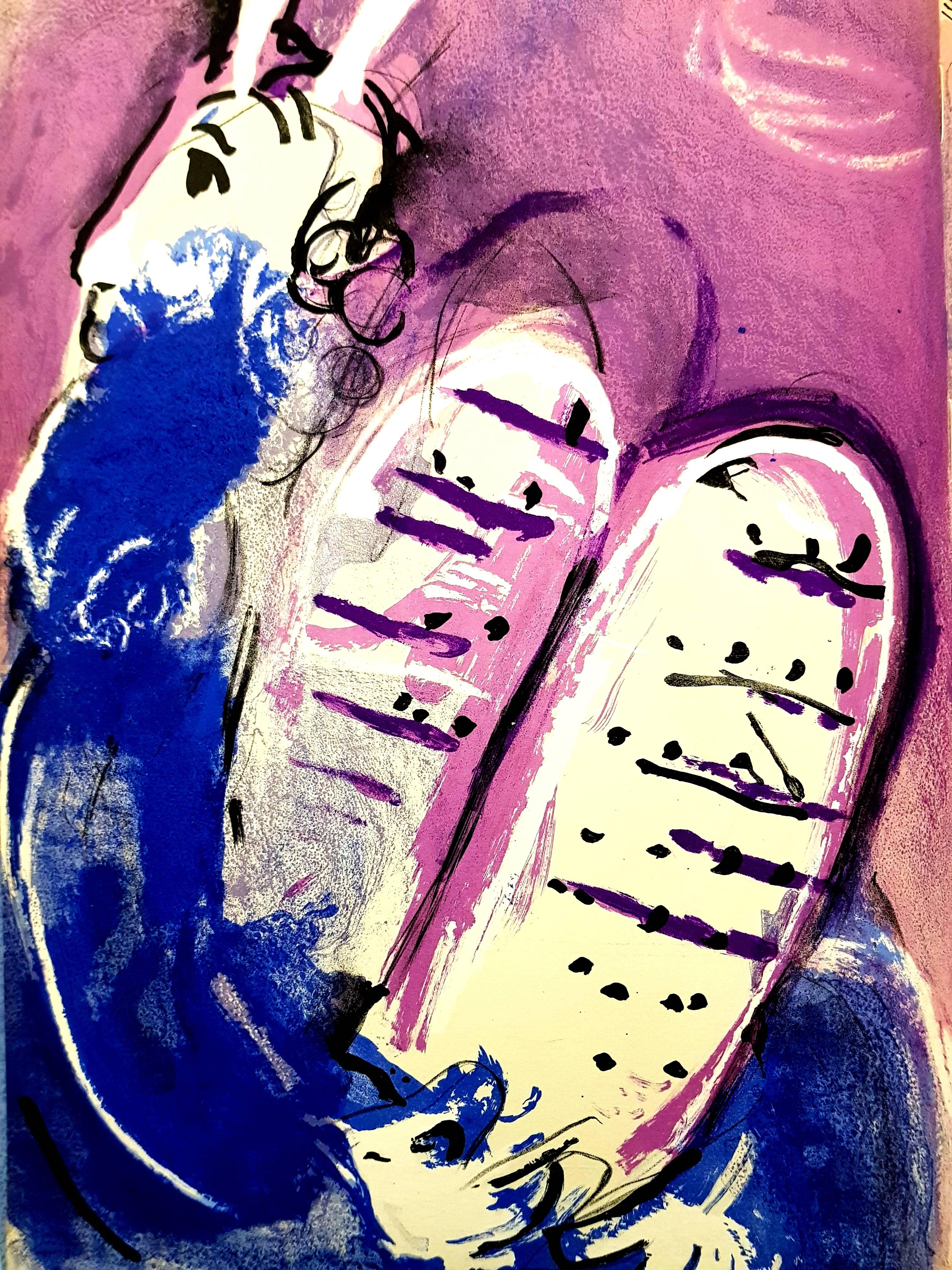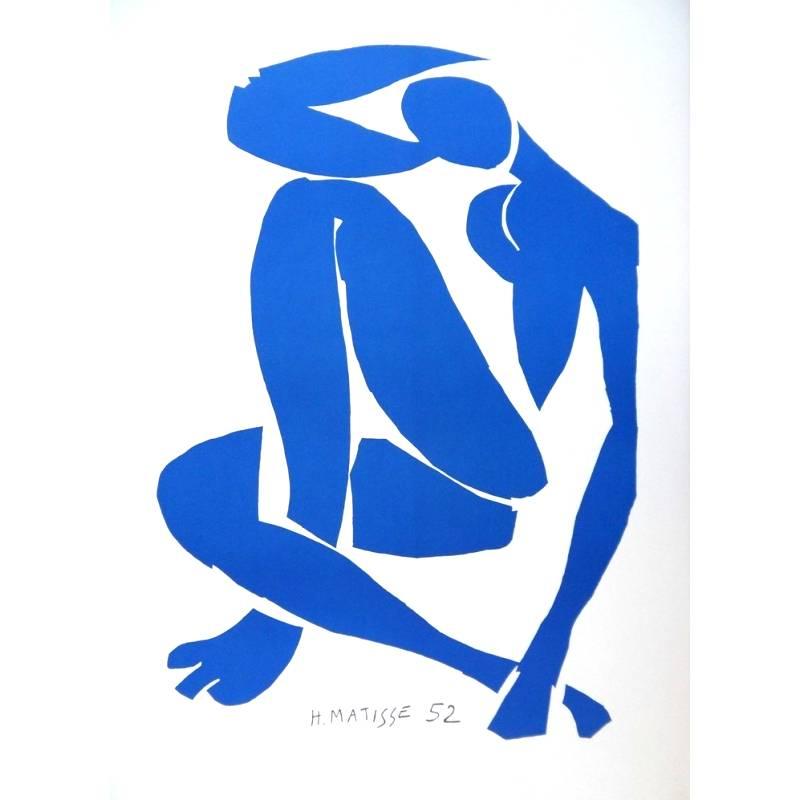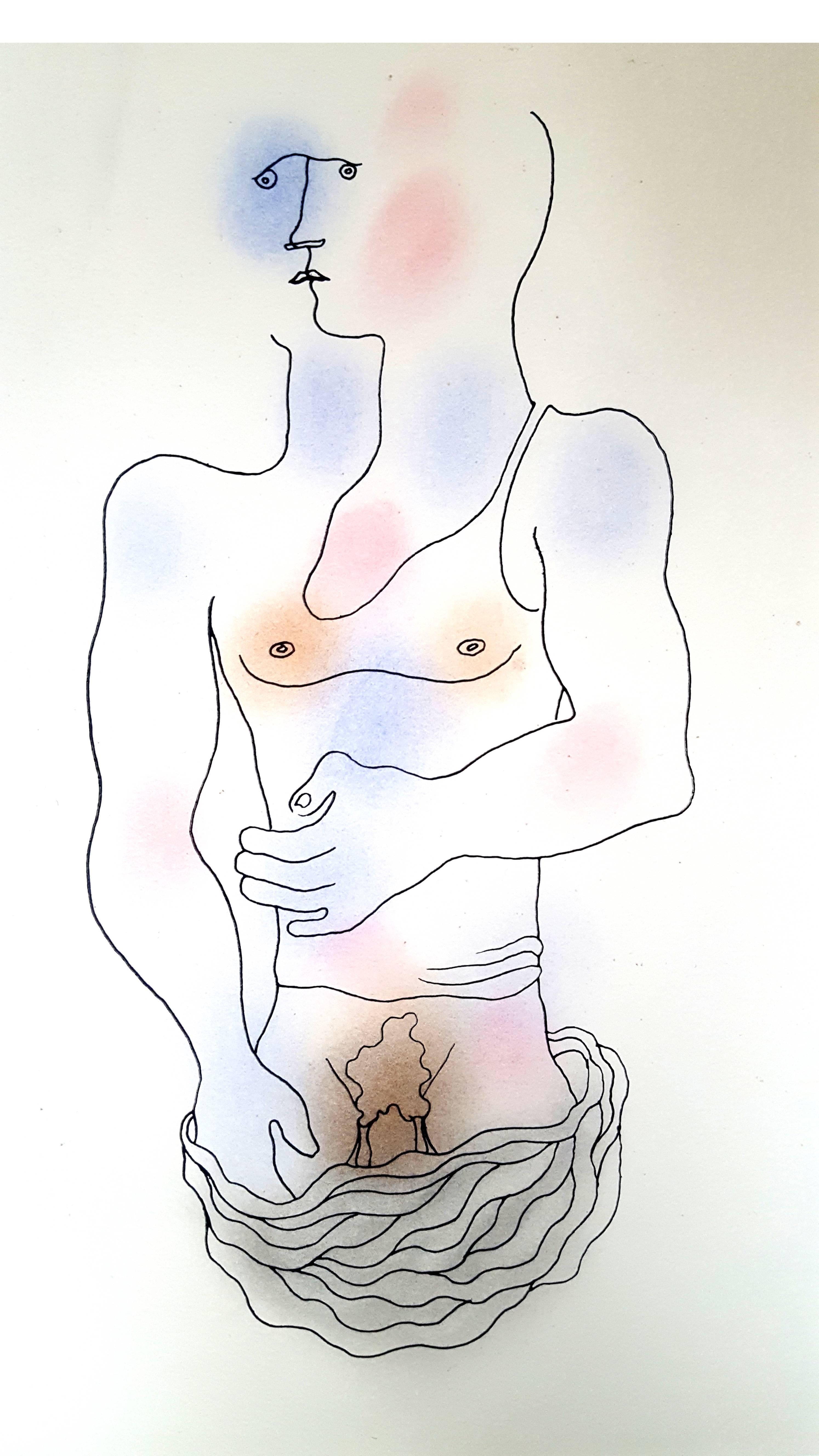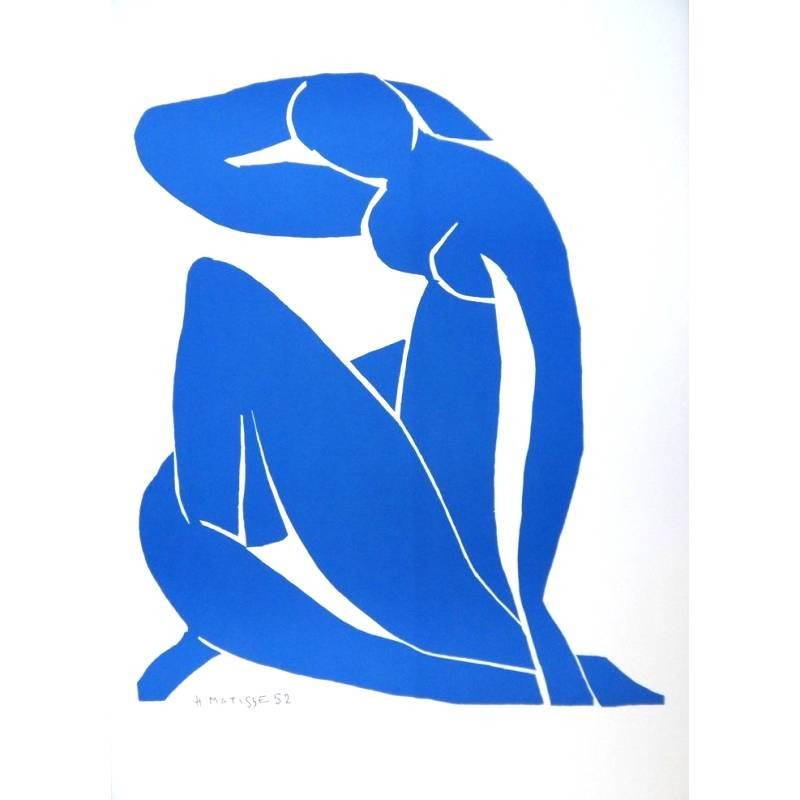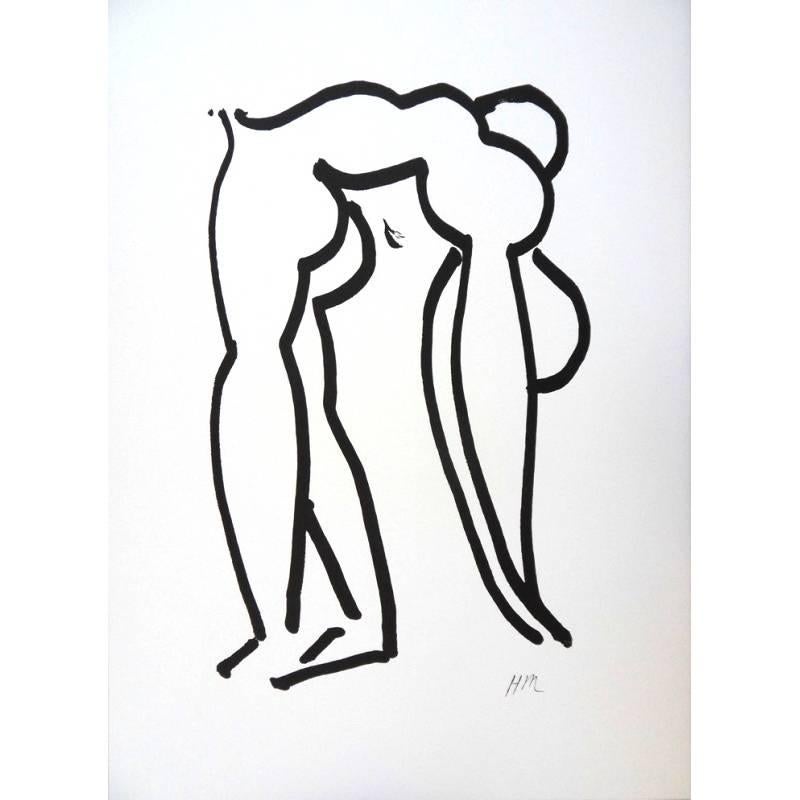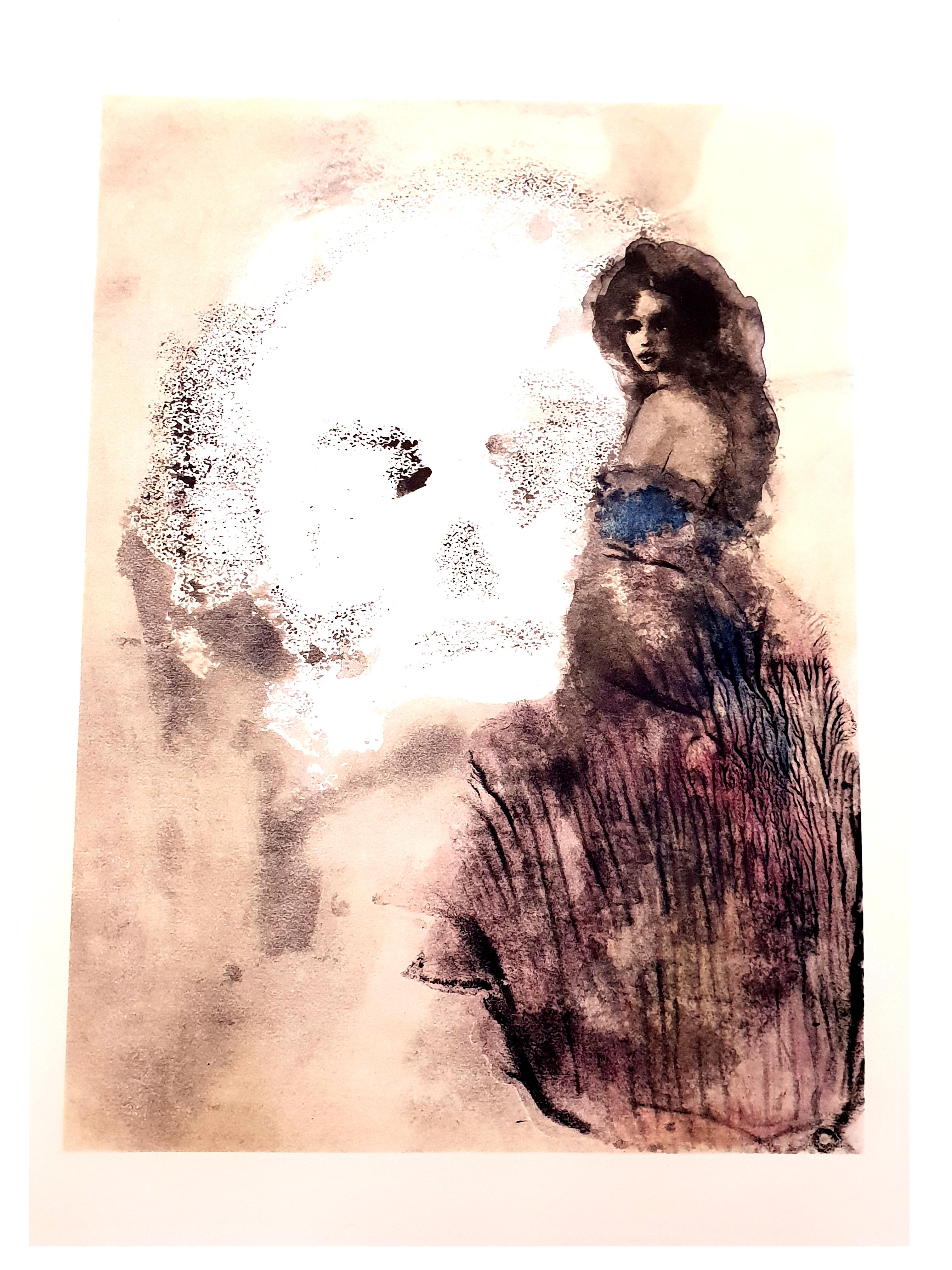Alberto Giacometti"Annette, " Original Black and White Lithograph Portrait by Alberto Giacometti1964-1965
1964-1965
About the Item
- Creator:Alberto Giacometti (1901 - 1966, Swiss)
- Creation Year:1964-1965
- Dimensions:Height: 20.5 in (52.07 cm)Width: 18 in (45.72 cm)
- Medium:
- Movement & Style:
- Period:
- Condition:
- Gallery Location:Milwaukee, WI
- Reference Number:
Alberto Giacometti
Alberto Giacometti was a painter, printmaker and furniture designer but he is best known as one of the 20th century’s most important sculptors. He is revered for the elongated, slender human figures he created in the years following World War II that reflected existentialism and the trauma associated with the conflict.
Giacometti was born in Borgonovo, Switzerland, in 1901 to a creative family. His father Giovanni was a Post-Impressionist painter, his godfather Cuno Amiet was a Fauvist painter, his brother Bruno was an architect, and his other brother Diego was an artist and furniture designer who also served as Giacometti’s model. (The sculptor worked chiefly with models plucked from his personal life.)
Beginning in 1922, Giacometti studied at the Académie de la Grande-Chaumière in Paris and was influenced by the Cubist work of Alexander Archipenko, Raymond Duchamp-Villon and the post-Cubist sculptures of Jacques Lipchitz and Henri Laurens.
During the 1930s, Giacometti designed furniture such as lamps, vases and wall décor to earn a living, often collaborating with interior designer Jean-Michel Frank, whose interiors tastefully mixed extravagance with sophisticated simplicity. However, Giacometti’s passion lay in creating sculptures.
Alberto and his brother Diego left Paris in 1940 to escape the Nazi invasion and spent time in the South of France before fleeing to Geneva, remaining there until 1946. In 1947, Giacometti began work on his most famous sculptures — very tall and thin figurines that came to be associated with frailty and loneliness.
Giacometti catapulted to fame in the United States following two exhibitions of his sculptures in 1948 and 1950 at the Pierre Matisse Gallery in New York City — Jean-Paul Sartre authored the catalogue essay for the latter. In 1961, Giacometti’s friend, Irish playwright Samuel Beckett, asked him to design the set for a re-staging of his play “Waiting for Godot.” His response took on the form of a single plaster tree.
In 1962, Giacometti won the grand prize for sculpture at the Venice Biennale, and for much of the rest of his career, he created modern paintings, drawings and sculptures of plaster, clay and bronze in his small Paris studio. He died in 1966.
Giacometti’s works continue to enthrall collectors. In 2010, his life-size bronze sculpture L'Homme qui marche (“the man who walks”), which now adorns the 100 Swiss Franc banknote, became one of the most expensive sculptures to be sold at auction.
On 1stDibs, discover a range of vintage Alberto Giacometti wall decorations, prints and sculptures.
- ShippingRetrieving quote...Ships From: Milwaukee, WI
- Return PolicyA return for this item may be initiated within 14 days of delivery.
- "Nude (Bonjour) Ed. of 600, " Color Lithograph signed by Paul GuiramandBy Paul GuiramandLocated in Milwaukee, WI"Nude (Bonjour)" is an original color lithograph by Paul Guiramand. The artist signed the piece in the lower right. This piece is from an edition of 600. It depicts a nude female fig...Category
1970s Nude Prints
MaterialsLithograph
- "Nude, " Lithograph Portrait of a Woman signed by Otto DixBy Otto DixLocated in Milwaukee, WI"Nude" is a lithograph by Otto Dix. It depicts the bust of a nude woman. The artist signed the piece lower right and wrote the edition number (28/XL) in the lower left. This piece wa...Category
1960s Expressionist Nude Prints
MaterialsLithograph
- "Erotica IV Marginala, " from the Mask of the Red Death series signed CastellonBy Federico CastellonLocated in Milwaukee, WIThis lithograph was one of sixteen Federico Castellón produced in 1968, published by Aquarius Press, to illustrate Edgar Allan Poe's 1832 story 'The Mask of the Red Death.' The image...Category
1960s Surrealist Figurative Prints
MaterialsLithograph
- "Erotica III Marginala, " from the Mask of the Red Death series signed CastellonBy Federico CastellonLocated in Milwaukee, WIThis lithograph was one of sixteen Federico Castellón produced in 1968, published by Aquarius Press, to illustrate Edgar Allan Poe's 1832 story 'The Mask of the Red Death.' The image...Category
1960s Surrealist Figurative Prints
MaterialsLithograph
- 'Nude Male and Nude Female, ' original lithograph pair signed by R.C. GormanBy Rudolph Carl GormanLocated in Milwaukee, WIR. C. Gorman is better known for his images of colorful and elegant Navajo figures. This pair of prints, however, offers a view into his personal life. The pair of nude figures in th...Category
1970s Contemporary Nude Prints
MaterialsLithograph
- La Magie noire (Black Magic) ed, 16/275 color lithograph by Rene MagritteBy René MagritteLocated in Milwaukee, WIThis color lithograph printed in 2011, Magie noire (Black Magic), by the Surrealist artist, René Magritte, is number 16 in an edition of 275. Facsimile sig...Category
Mid-20th Century Surrealist Nude Prints
MaterialsLithograph
- Marc Chagall - Moses with Tablets of Stone - Original LithographBy Marc ChagallLocated in Collonge Bellerive, Geneve, CHMarc Chagall, Original Lithograph depicting an instant of the Bible. Technique: Original lithograph in colours Year: 1956 Sizes: 35,5 x 26 cm / 14" x 10.2" (sheet) Published by: Éditions de la Revue Verve, Tériade, Paris Printed by: Atelier Mourlot, Paris Documentation / References: Mourlot, F., Chagall Lithograph [II] 1957-1962, A. Sauret, Monte Carlo 1963, nos. 234 and 257 Marc Chagall (born in 1887) Marc Chagall was born in Belarus in 1887 and developed an early interest in art. After studying painting, in 1907 he left Russia for Paris, where he lived in an artist colony on the city’s outskirts. Fusing his own personal, dreamlike imagery with hints of the fauvism and cubism popular in France at the time, Chagall created his most lasting work—including I and the Village (1911)—some of which would be featured in the Salon des Indépendants exhibitions. After returning to Vitebsk for a visit in 1914, the outbreak of WWI trapped Chagall in Russia. He returned to France in 1923 but was forced to flee the country and Nazi persecution during WWII. Finding asylum in the U.S., Chagall became involved in set and costume design before returning to France in 1948. In his later years, he experimented with new art forms and was commissioned to produce numerous large-scale works. Chagall died in St.-Paul-de-Vence in 1985. The Village Marc Chagall was born in a small Hassidic community on the outskirts of Vitebsk, Belarus, on July 7, 1887. His father was a fishmonger, and his mother ran a small sundries shop in the village. As a child, Chagall attended the Jewish elementary school, where he studied Hebrew and the Bible, before later attending the Russian public school. He began to learn the fundamentals of drawing during this time, but perhaps more importantly, he absorbed the world around him, storing away the imagery and themes that would feature largely in most of his later work. At age 19 Chagall enrolled at a private, all-Jewish art school and began his formal education in painting, studying briefly with portrait artist Yehuda Pen. However, he left the school after several months, moving to St. Petersburg in 1907 to study at the Imperial Society for the Protection of Fine Arts. The following year, he enrolled at the Svanseva School, studying with set designer Léon Bakst, whose work had been featured in Sergei Diaghilev's Ballets Russes. This early experience would prove important to Chagall’s later career as well. Despite this formal instruction, and the widespread popularity of realism in Russia at the time, Chagall was already establishing his own personal style, which featured a more dreamlike unreality and the people, places and imagery that were close to his heart. Some examples from this period are his Window Vitebsk (1908) and My Fianceé with Black Gloves (1909), which pictured Bella Rosenfeld, to whom he had recently become engaged. The Beehive Despite his romance with Bella, in 1911 an allowance from Russian parliament member and art patron Maxim Binaver enabled Chagall to move to Paris, France. After settling briefly in the Montparnasse neighborhood, Chagall moved further afield to an artist colony known as La Ruche (“The Beehive”), where he began to work side by side with abstract painters such as Amedeo Modigliani and Fernand Léger as well as the avant-garde poet Guillaume Apollinaire. At their urging, and under the influence of the wildly popular fauvism and cubism, Chagall lightened his palette and pushed his style ever further from reality. I and the Village (1911) and Homage to Apollinaire (1912) are among his early Parisian works, widely considered to be his most successful and representative period. Though his work stood stylistically apart from his cubist contemporaries, from 1912 to 1914 Chagall exhibited several paintings at the annual Salon des Indépendants exhibition, where works by the likes of Juan Gris, Marcel Duchamp and Robert Delaunay were causing a stir in the Paris art world. Chagall’s popularity began to spread beyond La Ruche, and in May 1914 he traveled to Berlin to help organize his first solo exhibition, at Der Sturm Gallery. Chagall remained in the city until the highly acclaimed show opened that June. He then returned to Vitebsk, unaware of the fateful events to come. War, Peace and Revolution In August 1914 the outbreak of World War I precluded Chagall’s plans to return to Paris. The conflict did little to stem the flow of his creative output, however, instead merely giving him direct access to the childhood scenes so essential to his work, as seen in paintings such as Jew in Green (1914) and Over Vitebsk (1914). His paintings from this period also occasionally featured images of the war’s impact on the region, as with Wounded Soldier (1914) and Marching (1915). But despite the hardships of life during wartime, this would also prove to be a joyful period for Chagall. In July 1915 he married Bella, and she gave birth to a daughter, Ida, the following year. Their appearance in works such as Birthday (1915), Bella and Ida by the Window (1917) and several of his “Lovers” paintings give a glimpse of the island of domestic bliss that was Chagall’s amidst the chaos. To avoid military service and stay with his new family, Chagall took a position as a clerk in the Ministry of War Economy in St. Petersburg. While there he began work on his autobiography and also immersed himself in the local art scene, befriending novelist Boris Pasternak, among others. He also exhibited his work in the city and soon gained considerable recognition. That notoriety would prove important in the aftermath of the 1917 Russian Revolution when he was appointed as the Commissar of Fine Arts in Vitebsk. In his new post, Chagall undertook various projects in the region, including the 1919 founding of the Academy of the Arts. Despite these endeavors, differences among his colleagues eventually disillusioned Chagall. In 1920 he relinquished his position and moved his family to Moscow, the post-revolution capital of Russia. In Moscow, Chagall was soon commissioned to create sets and costumes for various productions at the Moscow State Yiddish...Category
1950s Modern Figurative Prints
MaterialsLithograph
- after Henri Matisse, "Sitting Blue Nude"By Henri MatisseLocated in Collonge Bellerive, Geneve, CHLithograph after Henri Matisse - Sitting Blue Nude Artist : after Henri MATISSE Edition of 200 76 x 56 cm With stamp of the Succession Matisse References : Artvalue - Succession Ma...Category
1950s Modern Nude Prints
MaterialsLithograph
- Jean Cocteau - White Book - Original Handcolored LithographBy Jean CocteauLocated in Collonge Bellerive, Geneve, CHJean Cocteau White Book - Autobiography about Cocteau's discovery of his homosexuality. The book was first published anonymously and created a scandal. Original Handcolored Lithograph...Category
1930s Modern Nude Prints
MaterialsLithograph
- after Henri Matisse - Sleeping Blue Nude - LithographBy (after) Henri MatisseLocated in Collonge Bellerive, Geneve, CHafter Henri MATISSE Edition of 200 with the printed signature, as issued 76 x 56 cm With stamp of the Succession Matisse References : Artvalue - Succession MatisseCategory
1950s Modern Nude Prints
MaterialsLithograph
- after Henri Matisse - AcrobatBy Henri MatisseLocated in Collonge Bellerive, Geneve, CHafter Henri Matisse - Acrobat Edition of 200 with the printed signature, as issued 76 x 56 With stamp of the Succession Matisse References : Artvalue - Succession MatisseCategory
1950s Modern Nude Prints
MaterialsLithograph
- Leonor Fini - Road to Death - Original LithographBy Leonor FiniLocated in Collonge Bellerive, Geneve, CHLeonor Fini - Road to Death - Original Lithograph The Flowers of Evil 1964 Conditions: excellent Edition: 500 Dimensions: 46 x 34 cm Editions: Le Cercle du Livre Précieux, Paris Un...Category
1960s Modern Nude Prints
MaterialsLithograph
